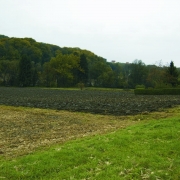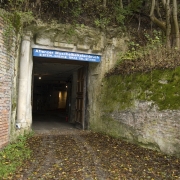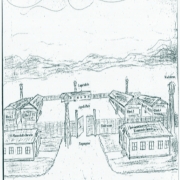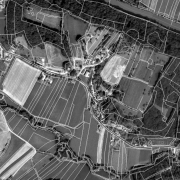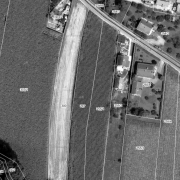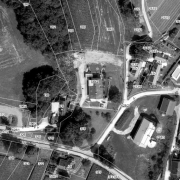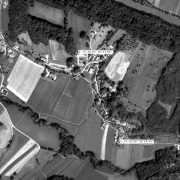Satellite Camp Wagna/Leibnitz
Gründung des Konzentrationslagers
Moving strategically important arms production underground had become necessary for Stery-Daimler-Puch AG in Graz, just like for many other companies. The Roman limestone quarry in Aflenz was chosen as a location for this, and prisoners of concentration camps had to work in it. It is assumed that the first prisoner transport, bringing 201 people, arrived in Leibnitz-Graz Subcamp from Mauthausen Concentration Camp on 8 February 1944. Hans Maršálek specifies 9 February 1944 as the establishment of the camp in his “Die Geschichte des Konzentrationslagers Mauthausen” (The history of Mauthausen Concentration Camp). Other historians specify 4 February 1944 as the date of its establishment.
Lokalisierung
The camp was on a meadow below the Roman quarry. The entire area was a restricted zone, and on the access road coming from Wagna, a so-called guard’s house was set up. Between the guard’s house and the subcamp, there was a relatively large labour camp that also housed some forced labourers. The tunnel system of the Roman quarry included several tunnels with numerous entrances. Parts of it are still accessible today upon pre-registration.
Informationen über die Häftlinge
The highest number of prisoners was recorded in June 1944, with 655 people. The majority of the prisoners were from the Soviet Union, Poland, Germany, Austria, and Yugoslavia. The strenuous working and living conditions as well as the murders led to the verifiable death of at least 78 prisoners.
Zwangsarbeit
The prisoners had to work on expanding the quarry and on digging tunnels. After the production facilities inside the tunnels were completed, the prisoners had to work in the production of aircraft and lorry parts. The mortality rate was especially high during the expansion of the tunnel. At first, the victims from Aflenz-Leibnitz Subcamp were brought to Mauthausen Concentration Camp or to Graz to be cremated, but later they were buried in a mass grave near the subcamp.
Bewachung
The prisoners were guarded by approximately 50 SS guards. Camp leaders were SS-Untersturmführer (Junior Assault Leader) Hals Altfuldisch, SS-Untersturmführer Fritz Miroff, and SS-Hauptscharführer (Chief Squad Leader) Paul Ricken. Altfuldisch and Miroff were sentenced to death and executed in the post-war trials. Ricken was sentenced to life in prison.
Schließung
Wagna-Leibnitz Subcamp was shut down on 2 April 1945. 467 prisoners from the Aflenz-Leibnitz camp were transferred to Ebensee. 407 of them reached Ebensee Subcamp on 18 April 1945. Eight weak prisoners were shot during the march, 49 tried to escape near Judenburg on 6 April, however, several of them were captured and shot.
Gedenken und Erinnern
After the war, the bodies in the mass grave near the camp were exhumed and buried in the cemetery of Ehrenhausen. In 1989, a memorial plaque was erected next to the tunnel system. Another monument was set up next to Leibnitz train station. In 2009, artists Helmut and Johanna Kandl redesigned the preserved guard’s house as a “memorial mark”. The premises of the former camp are now used for agriculture. The Mauthausen Committee Wagna/Leibnitz [1] organises the annual memorial celebration near the Roman quarry. The exact date can be found in the programme for commemoration and liberation ceremonies [2].
Tip: Contemporary witness Franz Trampusch leads through a 3D film and explains the conditions in the underground tunnel of the concentration camp Aflenz a.d.S. and its surroundings on YouTube: https://www.youtube.com/playlist?list=PLclxZYxl8wzR8iyNBfMKt2cKHkDaecnDR

